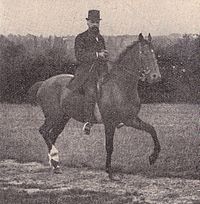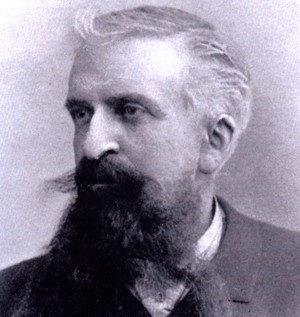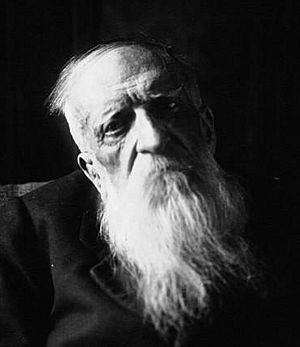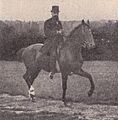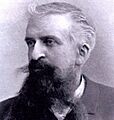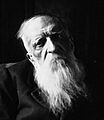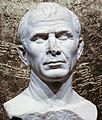Gustave Le Bon facts for kids
Quick facts for kids
Gustave Le Bon
|
|
|---|---|
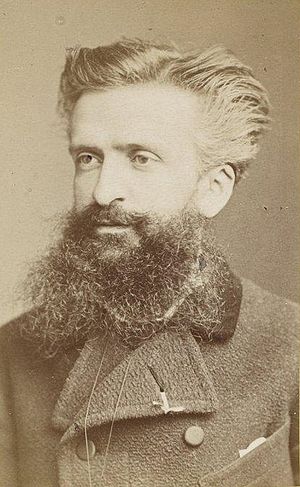
Gustave Le Bon, 1888
|
|
| Born |
Charles-Marie-Gustave Le Bon
7 May 1841 Nogent-le-Rotrou, France
|
| Died | 13 December 1931 (aged 90) Marnes-la-Coquette, France
|
| Resting place | Père Lachaise Cemetery |
| Nationality | French |
| Alma mater | University of Paris (M.D.) |
| Known for | The Crowd: A Study of the Popular Mind Crowd Psychology |
| Scientific career | |
| Fields | anthropology, psychology, sociology, medicine, engineering, physics |
| Influences | |
| Influenced | |
Charles-Marie Gustave Le Bon (born May 7, 1841 – died December 13, 1931) was a famous French thinker. He was a true polymath, meaning he was an expert in many different fields. His interests included anthropology (the study of human societies), psychology (the study of the mind), sociology (the study of how people live in groups), medicine, inventing, and physics (the study of matter and energy).
He is most known for his 1895 book, The Crowd: A Study of the Popular Mind. This book is considered a very important work in the field of crowd psychology, which looks at how people behave when they are part of a large group.
Gustave Le Bon was born in Nogent-le-Rotrou, France. He became a doctor of medicine from the University of Paris in 1866. However, he chose not to practice medicine. Instead, he started writing books and articles right after he graduated. He wrote about medical topics before joining the French Army. This was during the Franco-Prussian War. Seeing the defeat in this war and the events of the Paris Commune in 1871 greatly shaped his ideas about the world.
After the war, he traveled a lot. He visited Europe, Asia, and North Africa. He studied the people and cultures he met, focusing on the new field of anthropology. He also invented a portable tool to measure heads during his travels.
In the 1890s, he started focusing on psychology and sociology. This is when he wrote his most famous books. Le Bon believed that when people form a crowd, they create a new kind of "group mind." This group mind has its own characteristics, which are different from the people in it. At the same time, he also did experiments in physics. He wrote popular books about physics, even predicting ideas like mass–energy equivalence and the Atomic Age. Le Bon kept exploring many different subjects until he passed away in 1931.
Some French scientists and academics didn't always agree with Le Bon. This was because his political views were often traditional and against popular ideas like socialism.
Contents
Gustave Le Bon's Life
Early Years and Education
Charles-Marie Gustave Le Bon was born in Nogent-le-Rotrou, France, on May 7, 1841. His family had roots in the Bretons region of France. His father worked for the French government. When Gustave was eight, his family moved away from Nogent-le-Rotrou. The town later named a street after him, showing their pride. We don't know much about his childhood, except that he went to a high school in Tours. He wasn't a top student there.
In 1860, he began studying medicine at the University of Paris. He finished his training at a hospital called Hôtel-Dieu de Paris. He earned his medical degree in 1866. From then on, he called himself "Doctor," even though he never worked as a regular physician. During his university years, Le Bon wrote many articles on medical topics. His first article was about illnesses common in swampy areas. He also wrote about other diseases before publishing his first full book in 1866. This book was about how to define death.
Life in Paris and War Experiences
After graduating, Le Bon stayed in Paris. He taught himself English and German by reading Shakespeare's plays in both languages. He loved writing and wrote several papers on how the body works. In 1868, he wrote a textbook about sexual reproduction.
In July 1870, the Franco-Prussian War began. Le Bon joined the French Army as a medical officer. He helped organize military ambulances. During the war, he saw how soldiers behaved in very difficult situations, like total defeat. He wrote about what he learned about military discipline and leadership. His ideas were praised by generals and later studied at military schools in France. After the war, he received a special honor called the Chevalier of the Legion of Honour.
Le Bon also saw the Paris Commune in 1871. This event deeply affected his views. He watched as revolutionary crowds in Paris burned down important buildings like the Tuileries Palace and the Louvre library. These were irreplaceable works of art and architecture.
From 1871 onwards, Le Bon was against socialism and protectionism. He believed these ideas were hurting France's military and industry. He once said in 1913, "Only people with lots of cannons have the right to be pacifists." He also warned France about Germany's growing military power.
World Travels and Studies

In the 1870s, Le Bon became interested in anthropology, which is the study of human societies and cultures. He traveled across Europe, Asia, and North Africa. He was influenced by thinkers like Charles Darwin and Herbert Spencer. Le Bon believed that human traits and intelligence were linked to things like race and gender. After much research, he suggested a link between brain size and intelligence in his 1879 book. This book won him an award from the French Academy of Sciences. During his research, he invented a portable tool called a cephalometer to help measure people's physical features in distant places.
In 1884, the French government asked him to travel around Asia. He was to report on the civilizations there. His journeys led to several books. His ideas also developed to include the belief that culture is mainly shaped by a people's unique inherited traits. His first book, La Civilisation des Arabes, came out in 1884. In it, Le Bon praised Arabs for their contributions to civilization. But he criticized Islamism for causing a lack of progress. He also said their culture was better than that of the Turks who ruled them. Translations of this book inspired early Arab nationalism.
He then visited Nepal, becoming the first Frenchman to do so. He published Voyage au Népal in 1886. Next, he published Les Civilisations de l'Inde (1887). In this book, he admired Indian architecture, art, and religion. But he argued that Indians were not as advanced in science compared to Europeans. He felt this led to British rule. In 1889, he released Les Premières Civilisations de l'Orient. This book gave an overview of ancient civilizations like those in Mesopotamia, India, China, and Egypt. That same year, he gave a speech criticizing colonial policies that tried to make native people adopt European culture. He said, "Leave to the natives their customs, their institutions and their laws." Le Bon published his last travel book, Les monuments de l'Inde, in 1893. Again, he praised the amazing buildings created by the Indian people.
Developing His Theories
During his travels, Le Bon often rode horses. He noticed that horse trainers used different methods depending on the region. In 1892, back in Paris, he was thrown off a horse and almost died. He didn't know why it happened, so he decided to study what he did wrong. This led to his book L'Équitation actuelle et ses principes. Recherches expérimentales (1892). It had many photos of horses in action and Le Bon's analysis. This book became a respected guide for cavalry (soldiers on horseback). Le Bon used his studies of horse behavior to develop ideas about early childhood education.
His study of horses also sparked his interest in psychology. In 1894, he released Lois psychologiques de l'évolution des peuples. This book was dedicated to his friend Charles Richet. The next year, he published Psychologie des Foules (1895). This book became a bestseller and was translated into 19 languages within a year. Le Bon then wrote two more psychology books: Psychologie du Socialisme (1896) and Psychologie de l'Éducation (1902). These books were not popular with the mostly socialist academics in France.
In the early 1890s, Le Bon built a lab at home. In 1896, he claimed to have seen "black light." He thought this was a new type of radiation, different from X-rays. This "black light" was never confirmed to exist, but his claim got a lot of attention from French scientists. Many supported his ideas about matter and radiation. He was even nominated for the Nobel Prize in Physics in 1903.
In 1902, Le Bon started hosting weekly lunches. He invited important thinkers, nobles, and fashionable ladies. His guest list included famous people like Henri Poincaré, Paul Valéry, and Henri Bergson.
In his 1905 book L'Évolution de la Matière, Le Bon had ideas similar to mass–energy equivalence, which Albert Einstein later proved with his theory of relativity. Le Bon complained to Einstein in 1922 about not getting credit. Einstein replied, agreeing that the idea had been suggested before, but only his theory truly proved it. In L'Évolution des Forces (1907), Le Bon predicted the Atomic Age. He wrote about a "new force—namely intra-atomic energy—which surpasses all others by its colossal magnitude." He also said that a scientist who found a way to quickly break down one gram of metal would "not witness the results of his experiments ... the explosion produced would be so formidable that his laboratory and all neighbouring houses, with their inhabitants, would be instantaneously pulverised."
Le Bon stopped his physics research in 1908 and returned to psychology. He published several books between 1910 and 1914. In these, he shared his views on thinking, the psychology of different groups, and the history of civilization.
Later Life and Death
Le Bon continued writing during World War I. He published books like Enseignements Psychologiques de la Guerre Européenne (1915). After the war, he published Psychologie des Temps Nouveaux (1920). He then retired from his position as a professor at the University of Paris.
He published more books in the 1920s, sharing his thoughts on the world during the changing time between the two World Wars. In 1929, he received an even higher honor, becoming a Grand-Croix of the Legion of Honour. He published his last book in 1931 and died on December 13, 1931, at the age of 90.
A friend described him after his death: "Gustave Le Bon was a truly remarkable man. He had an exceptional mind. He was his own teacher and leader. Science and philosophy have lost a great person."
Le Bon's Main Ideas
Le Bon believed that human actions are guided by certain unchanging rules. He tried to combine the ideas of thinkers like Auguste Comte and Herbert Spencer with those of Jules Michelet and Alexis de Tocqueville.
Understanding Crowds
Le Bon believed that when people gather to form a crowd, something new happens. He called this a "psychological crowd." This crowd isn't just a group of individuals; it creates a shared "unconsciousness." He thought that a crowd has a "magnetic influence" that changes how each person behaves. Their actions become controlled by a "group mind."
In this model, the crowd acts as one unit. It takes away each person's own opinions, values, and beliefs. Le Bon said, "An individual in a crowd is a grain of sand amid other grains of sand, which the wind stirs up at will."
Le Bon pointed out three main things that create this psychological crowd:
- Anonymity: When you're in a crowd, you feel less visible. This can make people feel powerful and less responsible for their actions. Individuals might act more on their basic feelings and emotions.
- Contagion: This means that certain behaviors and feelings spread quickly through the crowd. People might give up their own interests for what the group wants.
- Suggestibility: This is how contagion happens. As the crowd becomes one mind, strong voices within the crowd can easily influence everyone. The crowd becomes easy to lead by its strongest members. Le Bon noted that these leaders are often people who act rather than just talk. They might not always think far ahead.
Le Bon's Impact
Le Bon's ideas about crowd psychology had a big impact on many people.
Some historians say that the ideas about leadership used by fascist leaders in the 1920s were influenced by Le Bon's theories. For example, Adolf Hitler read The Crowd and used Le Bon's ideas about propaganda techniques in his own book, Mein Kampf. Benito Mussolini also studied Le Bon's work carefully. Some people also see links between Le Bon's ideas and those of Vladimir Lenin and the Bolsheviks.
Before World War I, a thinker named Wilfred Trotter introduced Wilfred Bion to Le Bon's writings. Trotter's book Instincts of the Herd in Peace and War (1919) helped start the study of group dynamics. In the first half of the 1900s, media researchers like Hadley Cantril and Herbert Blumer used Le Bon's writings to understand how groups reacted to media.
Edward Bernays, who was a nephew of Sigmund Freud, was also influenced by Le Bon. In his important book Propaganda, Bernays said that a key part of democracy was how the mass media and advertising could influence voters. Some believe that American leaders like Theodore Roosevelt and Charles G. Dawes were also deeply affected by Le Bon's writings in the early 20th century.
Works
About People and Society
- History of the Origins and Development of Man and Society (1877)
- Man and Society (1881)
- The World of Islamic Civilization (1884)
- Travel to Nepal (1886)
- The Civilisations of India (1887)
- The First Civilisations of the Orient (1889)
- The Monuments of India (1893)
- The Psychology of Peoples (1894)
- The Crowd: A Study of the Popular Mind (1895)
- The Psychology of Socialism (1896)
- The Psychology of Education (1902)
- The Psychology of Politics and Social Defense (1910)
- Opinions and Beliefs (1911)
- The Psychology of Revolution (1912)
- Aphorisms of Present Times (1913)
- Truths of Life (1914)
- The Psychology of the Great War (1915)
- First Consequences of War: Mental Transformation of Peoples (1916)
- Yesterday and Tomorrow. Brief thoughts (1918)
- The World in Revolt (1920)
- The World Unbalanced (1923)
- The Uncertainties of the Present Hour (1924)
- The Current Evolution of the World, Illusions and Realities (1927)
- Scientific Basis for a Philosophy of History (1931)
About Science
- The Graphical Method and recording devices (1878)
- Anatomical and mathematical research on the changes in brain volume and its relationships with intelligence (1879)
- Tobacco smoke (1880)
- Photographic surveying (1888)
- Equitation: The Psychology of the Horse (1892)
- The Evolution of Matter (1905)
- The birth and disappearance of matter (1907)
- The Evolution of Forces (1907)
Images for kids
See also
 In Spanish: Gustave Le Bon para niños
In Spanish: Gustave Le Bon para niños



